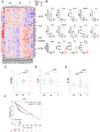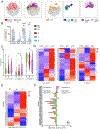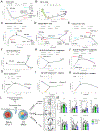The tumour microenvironment shapes innate lymphoid cells in patients with hepatocellular carcinoma
- PMID: 34340996
- PMCID: PMC8807808
- DOI: 10.1136/gutjnl-2021-325288
The tumour microenvironment shapes innate lymphoid cells in patients with hepatocellular carcinoma
Abstract
Objective: Hepatocellular carcinoma (HCC) represents a typical inflammation-associated cancer. Tissue resident innate lymphoid cells (ILCs) have been suggested to control tumour surveillance. Here, we studied how the local cytokine milieu controls ILCs in HCC.
Design: We performed bulk RNA sequencing of HCC tissue as well as flow cytometry and single-cell RNA sequencing of enriched ILCs from non-tumour liver, margin and tumour core derived from 48 patients with HCC. Simultaneous measurement of protein and RNA expression at the single-cell level (AbSeq) identified precise signatures of ILC subgroups. In vitro culturing of ILCs was used to validate findings from in silico analysis. Analysis of RNA-sequencing data from large HCC cohorts allowed stratification and survival analysis based on transcriptomic signatures.
Results: RNA sequencing of tumour, non-tumour and margin identified tumour-dependent gradients, which were associated with poor survival and control of ILC plasticity. Single-cell RNA sequencing and flow cytometry of ILCs from HCC livers identified natural killer (NK)-like cells in the non-tumour tissue, losing their cytotoxic profile as they transitioned into tumour ILC1 and NK-like-ILC3 cells. Tumour ILC composition was mediated by cytokine gradients that directed ILC plasticity towards activated tumour ILC2s. This was liver-specific and not seen in ILCs from peripheral blood mononuclear cells. Patients with high ILC2/ILC1 ratio expressed interleukin-33 in the tumour that promoted ILC2 generation, which was associated with better survival.
Conclusion: Our results suggest that the tumour cytokine milieu controls ILC composition and HCC outcome. Specific changes of cytokines modify ILC composition in the tumour by inducing plasticity and alter ILC function.
Keywords: hepatocellular carcinoma; immune response; immunology; immunoregulation; liver immunology.
© Author(s) (or their employer(s)) 2022. No commercial re-use. See rights and permissions. Published by BMJ.
Conflict of interest statement
Competing interests: None declared.
Figures






Comment in
-
Commentary on "The tumour microenvironment shapes innate lymphoid cells in patients with hepatocellular carcinoma".Hepatobiliary Surg Nutr. 2022 Apr;11(2):288-291. doi: 10.21037/hbsn-21-521. Hepatobiliary Surg Nutr. 2022. PMID: 35464262 Free PMC article. No abstract available.
-
Comment on: the tumour microenvironment shapes innate lymphoid cells in patients with hepatocellular carcinoma.Hepatobiliary Surg Nutr. 2022 Apr;11(2):280-282. doi: 10.21037/hbsn-21-519. Hepatobiliary Surg Nutr. 2022. PMID: 35464274 Free PMC article. No abstract available.
References
-
- Budhu A, Wang XW. The role of cytokines in hepatocellular carcinoma. Journal of leukocyte biology 2006;80:1197–213. - PubMed
-
- Hou J, Zhang H, Sun B, Karin M. The immunobiology of hepatocellular carcinoma in humans and mice: Basic concepts and therapeutic implications. Journal of hepatology 2020;72:167–82. - PubMed
-
- Vivier E, Artis D, Colonna M, Diefenbach A, Di Santo JP, Eberl G, et al. Innate lymphoid cells: 10 years on. Cell 2018;174:1054–66. - PubMed
-
- Forkel M, Berglin L, Kekalainen E, Carlsson A, Svedin E, Michaelsson J, et al. Composition and functionality of the intrahepatic innate lymphoid cell-compartment in human nonfibrotic and fibrotic livers. European journal of immunology 2017;47:1280–94. - PubMed
MeSH terms
Substances
Grants and funding
LinkOut - more resources
Full Text Sources
Medical
Molecular Biology Databases
